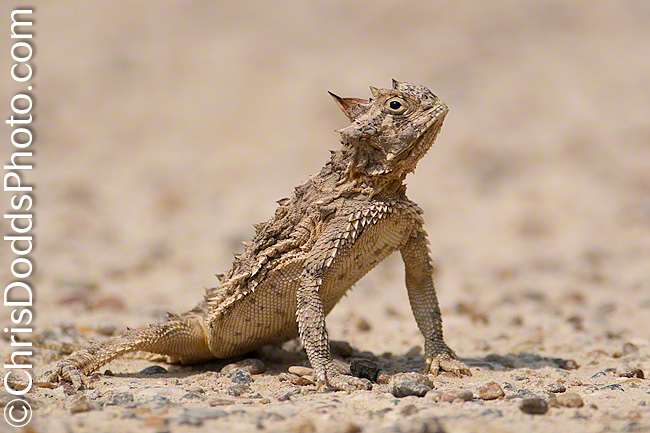 Texas Horned Lizard Phrynosoma cornutum (Also known as: Great Horney Toad, Horned Toad, Horny Toad, Horned Frog) Estero Llano Grande State Park, Weslaco, Texas. Image Copyright ©Christopher Dodds All Rights Reserved. Canon 1D MK IV, 500mm F4 L IS, 2X Teleconverter III Hand-held grab shot. ISO 400, F8 @1/2000s Manual mode. CLICK HERE TO PURCHASE A PRINT or LICENSE IMAGE FOR PUBLICATION
Texas Horned Lizard Phrynosoma cornutum (Also known as: Great Horney Toad, Horned Toad, Horny Toad, Horned Frog) Estero Llano Grande State Park, Weslaco, Texas. Image Copyright ©Christopher Dodds All Rights Reserved. Canon 1D MK IV, 500mm F4 L IS, 2X Teleconverter III Hand-held grab shot. ISO 400, F8 @1/2000s Manual mode. CLICK HERE TO PURCHASE A PRINT or LICENSE IMAGE FOR PUBLICATION
I'm just back from an awesome trip to Texas, and preparing to leave for Florida. I was thrilled to discover this Texas Horned Lizard on a path near the visitor centre after spending the morning photographing birds at Estero Llano Grande State Park. The Park interpreter that I spoke to had only seen this species in the park on two other occasions. Because my tripod was set-up at it's maximum height, and I knew there was a chance the Horned Lizard would run for cover before I could lower it, I quickly removed my camera from the tripod and used my knee (in the crouching position) to stabilize the rig. I pulled off three frames before it took-off (only because someone walked toward it from the opposite side), this is the only one of those three with a catchlight in the eye. Here's what I've learned about the species from Wikipedia:
The Texas Horned Lizard (Phrynosoma cornutum) is one of 14 North American species of spikey-bodied reptiles called horned lizards. P. cornutum ranges from Colorado and Kansas to northern Mexico, and from southeastern Arizona to Texas. There are also isolated, introduced populations in the Carolinas, Georgia, and northern Florida. Texas horned lizards may be native to Louisiana and Arkansas.
The horned lizard is popularly called a "horned toad," "horny toad," or "horned frog," but it is neither a toad nor a frog. The popular names come from the lizard's rounded body and blunt snout, which give it a decidedly toad- or frog-like appearance. Phrynosoma literally means "toad-bodied," and Cornutum means "horned." The lizard's horns are extensions of its cranium and are composed of true bone.
The Texas horned lizard is the largest-bodied and most widely distributed of 14 species in the western United States and Mexico. The length of an average Texas Horned Lizard is 69 mm (2.7 in) snout-vent length, however the upper boundary for males is 94 mm (3.7 in) and for females it is 114 mm (4.5 in). Although its coloration generally serves as camouflage against predation, when threatened by a predator, a horned lizard will puff up its body to cause its spiny scales to protrude, making it difficult to swallow. The Texas horned lizard, along with at least three other species, also has the ability to squirt an aimed stream of blood from the corners of the eyes and sometimes from its mouth for a distance of up to 5 ft (1.5 m). This not only confuses would-be predators, the blood is mixed with a chemical that is foul-tasting to canine predators such as wolves, coyotes, and domestic dogs.
About 70% of the Texas horned lizard's diet is made up of harvester ants, though they supplement these with termites, beetles, and grasshoppers. In recent years, the Texas horned lizard has declined in about 30% of its range, though there is some indication it may be making a comeback. The decline is usually blamed on overuse of pesticides and the spread of non-native, but highly aggressive and fiercely territorial, red imported fire ants. Both eradicate harvester ant colonies, destroying the horned lizard's principal source of food. The Texas horned lizard is now a protected species and it is illegal to take, possess, transport or sell them without a special permit.
Some Native American peoples regard horned lizards as sacred. The animal is a common motif in the art of many Native Americans in the Southwestern U.S. and in Mexico. The Texas horned lizard is the state reptile of Texas and, as the "horned frog", is the mascot of Texas Christian University (TCU).